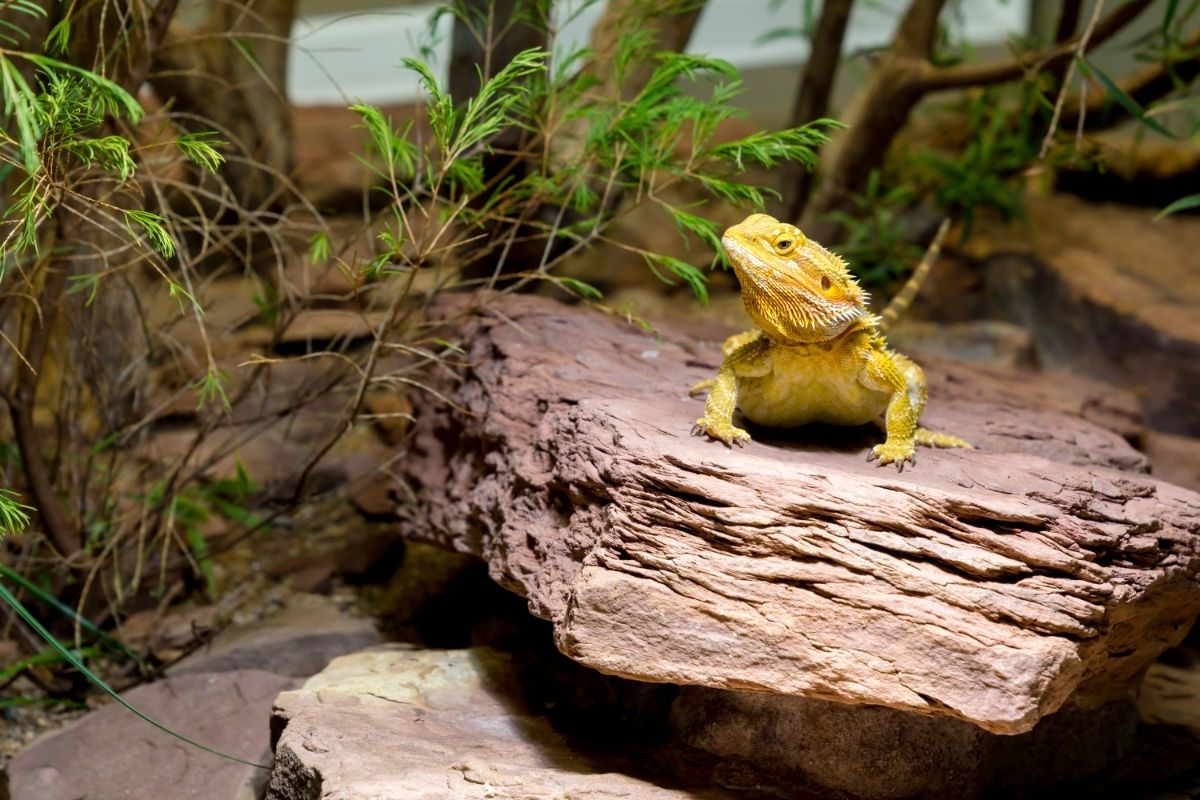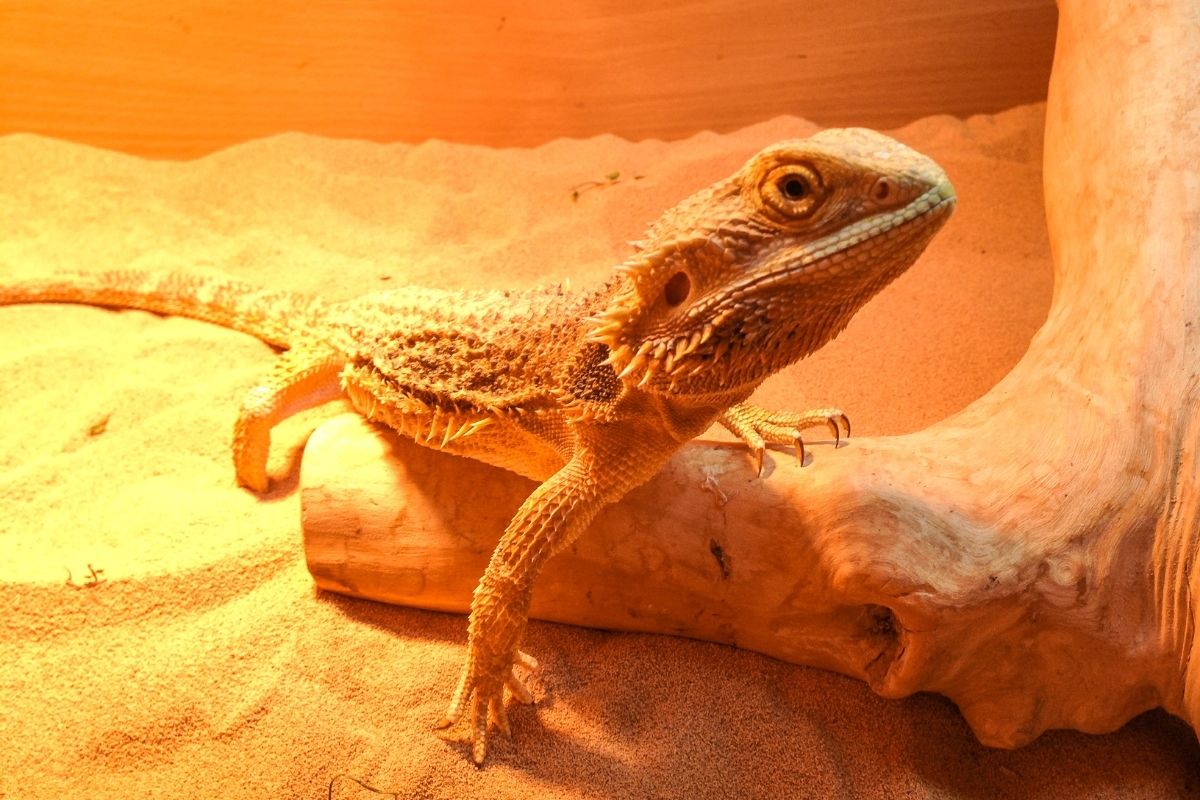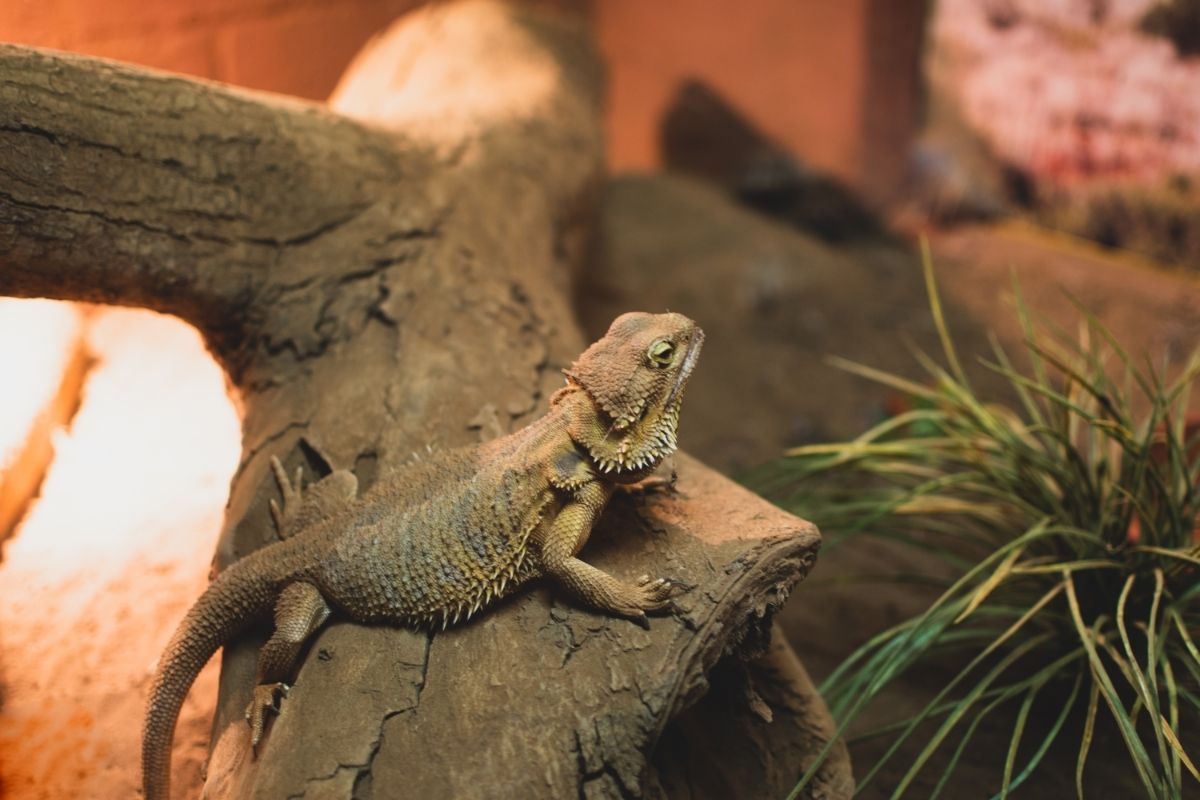Basking is typical bearded dragon behavior. This is when they find themselves a sunny spot, stretch out, and soak up the light and heat.
As cold-blooded animals, this helps the bearded dragon to regulate its body temperature.

As bearded dragon owners, we recreate this behavior using a heat lamp.
By using a beam of heat and light, we can create a warm basking area reminiscent of the bearded dragons’ Australian home.
And as our beardies seem to love basking so much, it’s tempting to leave the heat lamp on all night.
That way, they can enjoy basking even when everyone else is in bed.
However, bearded dragons need time to sleep, and they need darkness and slightly cooler temperatures to do so.
In this guide, we’ll discuss all the reasons to turn the heat lamp off overnight and what you can do to ensure your beardie has a comfortable sleep.
Do Bearded Dragons Need The Heat Lamp Left On Overnight?
Creating a comfortable enclosure for your pet is about understanding their needs and what they would expect to find in their native environment.
For the bearded dragon, that means emulating the conditions of Australia, where the species evolved and adapted.
In Australia, the bearded dragon would be exposed to high temperatures and regular sunlight.
This is where they feel comfortable, and the sun and heat allow them to bask.
Temperatures that might feel uncomfortable to us are perfect for the bearded dragon.
In captivity, this translates into exposing your bearded dragon to heat lamps and allowing them to bask during the day.
This allows them to regulate their body temperature naturally, which is essential for their health.
However, at night, the bearded dragon is used to the darkness and cooler temperatures. At this time, they can rest, and their body can repair and rejuvenate.
Proper rest is essential for the healthy functioning of a bearded dragon.
In an enclosure, that means providing the bearded dragon with periods of darkness.
Overnight, the heat lamp should be turned off so the bearded dragon can sleep.
If the heat lamp is left on, the bearded dragon won’t recognize that it’s nighttime. Instead, they’ll feel exposed and alert.
Instead of resting, the bearded dragon will keep an eye out for predators and won’t find the safety they need for proper sleep.
They’ll also be expecting the heat to drop to signal the nighttime. With a heat lamp on constantly, your bearded dragon won’t know what’s going on.
It’s important for your bearded dragon’s health to turn the heat lamp off overnight.
In their Australian home, the temperatures might never drop particularly low during the night.
Many owners worry that without the heat lamp, the bearded dragon will get too cold.
To avoid this, look for other ways to control temperature without adding extra light.
How Long Should You Leave A Heat Lamp On For A Bearded Dragon?

Correctly heating and lighting your bearded dragon enclosure requires an understanding of the natural environment your bearded dragon has adapted to.
In Australia, temperatures and hours of daylight don’t stay consistent throughout the year. Seasonal changes will affect how the bearded dragon behaves.
It’s necessary to consider these factors when designing your enclosure.
In our own homes, we try to keep the seasons out and maintain a steady temperature all year round.
However, we still interact with the seasons whenever we leave the house.
A bearded dragon in an enclosure won’t have this experience, so won’t know the seasons are happening at all.
Instead, you need to adjust the lighting and heating to accurately emulate the seasons and times of the day.
The amount of time you leave the heat lamp on can mimic these natural changes.
To create this effect, adjust how long the heat lamp is on each day.
We recommend 12 hours in spring, 14 hours in summer, 12 hours in fall, and 10 hours in winter.
This will give the impression of warmer days and nights at different times of the year.
The basking area in an enclosure should be kept at a temperature of 95 to 100 degrees F.
Your bearded dragon will sit in this sunny spot the same way they would soak up the sunlight in the wild.
But bearded dragons won’t necessarily need to bask all day. To prevent them from overheating, you should provide a temperature gradient in the enclosure.
Although the basking area should be 95 to 100 degrees, the ambient temperature should be closer to 75 to 80 degrees F.
And at night, the temperature should drop to between 75 and 70 degrees F. Avoid letting the temperature fall below 65 degrees.
With a variety of temperatures to choose from, your bearded dragon can move about the enclosure comfortably.
For an inexpensive and effective way of monitoring temperature, we recommend the Zoo Med Digital Thermometer.
Pick it up from Chewy.com, or Amazon.com.
Creating A Lighting Cycle For Your Bearded Dragon
Adjusting the heat lamp hours will give the bearded dragon the time it needs to sleep. Bearded dragons need between 8 and 12 hours of sleep every day.
Their natural cycle and rhythms will be disrupted if they aren’t sleeping regularly.
To ensure your bearded dragon is getting enough sleep year-round, adjust the lighting hours to match the seasons.
During spring and summer, when days are longer and lighter, provide light for 14 to 16 hours.
During fall and winter, colder and darker seasons, the light should be on for 10 to 12 hours.
The easiest way to do this is by using a timer. Set the timer to turn off the lights after the desired length of time.
Timers can be used to develop a healthy rhythm for your beardies days and nights.
Then, when the seasons change, you can adjust the timer to reflect the new time period.
It takes the stress out of your hands and will ensure your bearded dragon is getting the perfect amount of light and heat.
Manually switching the heat lamp on and off doesn’t seem very difficult, but one early night or late morning can throw off your beardies’ entire routine.
And with the timer, you never have to lie in bed thinking: did I turn the lamp off?
There are many automatic timers available. In fact, you might already own one.
If not, we recommend the Zilla Digital Lighting and Terrarium Heat Power Center for Reptile Habitats (also available from Chewy.com). This timer is silent and easy to control, with an LED display to make your timings more precise than ever.
What Overnight Temperature Is Best For A Bearded Dragon?
During the daytime, your bearded dragon will often be quite happy finding the sunniest spot and basking there.
This is how they’d behave in the wild, albeit keeping an eye out for predators and threats.
However, at night, things change. Even in the Australian summertime, the night can come with a big drop in temperature.
Under the safety of darkness, the bearded dragon will rest and allow the body to repair and save energy.
At night, you should strive to keep the temperature in the enclosure between 70 and 75 degrees F. Avoid going too low or too high.
Bearded dragons are cold-blooded and rely on the environment to regulate their temperature.
Keeping the enclosure temperature steady can often run into two problems, depending on the time of year and where you live.
Either the ambient temperature of the room is too hot or it’s too cold.
If it’s too hot, cool the enclosure using air conditioning and fans.
You might also want to turn the heat lamp off for longer and use other forms of lighting. Another option is misting.
Mist in the morning or evening when the heat lamp isn’t on. Don’t mist when the lamp is on because this can create excess humidity.
Bearded dragons are desert animals and don’t appreciate a humid environment.
But don’t let the enclosure get too cool. Temperatures shouldn’t drop below 65 degrees F. How do you do this without the heat lamp?
Keeping Your Bearded Dragon Warm At Night

Bearded dragons are cold-blooded. This means they can’t regulate their internal temperature and rely on external factors to keep them comfortable.
In the wild, that means basking during the day, sleeping at night, and avoiding anywhere too warm or too cold.
If the temperature swings too far one way or the other, the health of the bearded dragon can suffer.
In an enclosure, a bearded dragon doesn’t have the same freedom to find gradients in temperature.
Instead, it’s an owner’s job to ensure your pet bearded dragon has a range of climates to enjoy. Without the correct heating, your beardie could become ill.
It’s not unusual to come down in the morning and find your bearded dragon is cool to touch.
Its body will have chilled with the lower night temperatures, slowing the metabolism. After some time under the heat lamp, they’ll be right back to normal.
But if the enclosure has been allowed to get cold, your bearded dragon will be stressed, upset, and unable to warm up.
So, how can you keep your bearded dragon as comfortable as possible?
First, think about the tank itself. Glass enclosures should hold onto the heat from the day and avoid losing too much overnight.
Next, choose the right place for the enclosure. Don’t keep it next to a window, where temperatures will be out of your control.
Similarly, you want to keep it away from doors and vents that might provide a draft.
Although airflow is good, the tank shouldn’t be directly in the path of a breeze.
Instead, find a cozy corner with a stable climate. Think about the heating you use in your own house and how that might affect the enclosure.
Consider how long the heat lamp is on each day. Are you turning it off too soon and not giving the tank a chance to warm?
Or are you leaving it too long and letting the enclosure overheat? Make sure you’re allowing the heat lamp to work properly by using set timings.
Heat lamps shouldn’t be left on overnight because they provide light and heat. For a cold tank, invest in bulbs that emit heat without light.
These can be left on overnight, warming the tank and providing a dark environment for your beardie to nap.
One option is an Infrared Basking Lamp. This provides warmth but only emits a red light, which won’t disturb sleep.
Try this Exo Terra Infrared Basking Reptile Spot Lamp, available from Chewy.com and Amazon.com.
Or you can try a ceramic heat emitter. Like the infrared bulbs, these don’t give off any light, so your bearded dragon can get some sleep.
Try this option from Zoo Med, available from Chewy.com and Amazon.com.
If it still isn’t warm enough, another option is a heat mat.
Heat mats provide a layer of warmth at the bottom of an enclosure and can boost the ambient temperature of the tank.
These can help to raise the temperature, but shouldn’t be the only way an enclosure gets heated.
In the wild, a bearded dragon would get most of its warmth from above. They’ve adapted to the hot Australian sun.
A beardie can burn if exposed to too much heat from underneath.
Check out this Exo Terra Ultra Thin Terrarium Substrate Heat Mat at Chewy.com or Amazon.com.
Before you move your bearded dragon in, monitor the temperature of the enclosure during the day and overnight for several weeks.
It might seem like extra effort up front, but it’s worth it to keep your bearded dragon happy and healthy.
We recommend investing in a thermometer that will tell you the minimum and maximum temperature during a set time period.
This way, you can see exactly how stable the temperature remains overnight.
It might be that in the evening or early morning, the tank warms up to a suitable level, but during the night, it drops below 60 degrees.
Be sure with a min/max thermometer, such as this min-max digital thermometer from Zoo Med.
If you don’t have a min/max thermometer, we recommend setting a timer and waking up several times during the night to manually take the temperature.
Ensuring The Right Lighting And Temperature For Your Bearded Dragon
We all want to do the best for our bearded dragons, and that means getting the heating and lighting just right.
Use a timer to automate your lighting and heating, which reduces the stress on you, and will establish a routine for your bearded dragon.
With the lights coming on and off at the same time every day, your beardie will wake and sleep as necessary and develop a healthy circadian rhythm.
A timer can also help ensure your bearded dragon tank is at just the right temperature.
During the night, the enclosure shouldn’t get any cooler than 65 degrees F. During the day, avoid creating a basking area that’s hotter than 100 degrees F.
With the heat lamp turned on and off by a timer, the enclosure can reach and maintain optimum temperature.
Always turn your heat lamp off overnight. Otherwise, excess light will keep your bearded dragon awake and raise the temperature.
Use a timer to automate the heat and light at night and during the day.
Don’t forget to adjust for the seasons and introduce heat bulbs if the enclosure is suffering from cooler nights.
Frequently Asked Questions
Should You Leave A Heat Lamp On Overnight For Your Bearded Dragons?
Don’t leave the heat lamp on overnight for your bearded dragon.
The excess heat and light will disturb their natural rhythms and leave them unable to properly rest.
Make sure the lights are off for 8 to 12 hours every day, so your bearded dragon can get a proper night’s sleep.
If you’re worried the tank will get too cold with the lamp turned off, invest in heat bulbs that give off no light.
Do Bearded Dragons Need Heat At Night?
Bearded dragons do need some heat at night, but not as much as they need during the day.
In their natural environment, they’ll be used to colder temperatures overnight.
Aim for an ambient nighttime temperature of around 70 to 75 degrees Fahrenheit.
Avoid letting the enclosure get any colder than 65 degrees F. Bearded dragons are cold-blooded and can’t regulate their own heat.
If it gets too cold, this can be fatal.
How Long Should A Heat Lamp Be On For A Bearded Dragon?
A heat lamp should be on for at least 10 hours every day and left on for longer during warmer months.
The seasons affect how long a heat lamp should be left on.
During winter, 10 hours should be enough (provided you don’t let it get too cold overnight). In spring and fall, 12 hours is better. In summer, aim for 14 hours.
Use a digital thermometer to accurately measure the temperature in the enclosure, and make sure to leave some cooler spots for your beardie to rest in.
